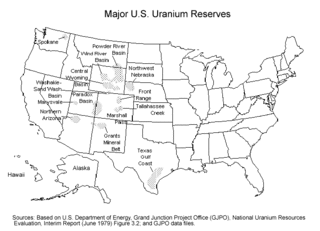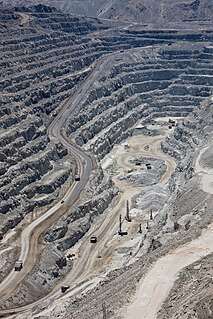Related Research Articles
Elim is a city in Nome Census Area, Alaska, United States. At the 2010 census the population was 330, up from 313 in 2000.

The Navajo Nation is a Native American territory covering about 17,544,500 acres, occupying portions of northeastern Arizona, northwestern New Mexico and a smaller portion covering southeastern Utah, in the United States. This is the largest land area retained by a Native American tribe in the United States. By area, the Navajo Nation is larger than ten U.S. states. In 2010, the total population of Navajo tribal members was 332,129 with 173,667 living within the boundaries of the reservation and 158,462 tribal members outside of the reservation. Metropolitan areas accounted for 26 percent of the population, border towns accounted for ten percent, and the remaining 17 percent were living elsewhere in the U.S. The seat of government is located in Window Rock, Arizona.

The Kerr-McGee Corporation, founded in 1929, was an American energy company involved in oil exploration, production of crude oil, natural gas, perchlorate and uranium mining and milling in various countries. On June 23, 2006, Anadarko Petroleum acquired Kerr-McGee in an all-cash transaction totaling $16.5 billion plus $2.6 billion in debt and all operations moved from their base in Oklahoma, United States.

Mount Taylor is a dormant stratovolcano in northwest New Mexico, northeast of the town of Grants. It is the high point of the San Mateo Mountains and the highest point in the Cibola National Forest.

Uranium mining is the process of extraction of uranium ore from the ground. The worldwide production of uranium in 2019 amounted to 53,656 tonnes. Kazakhstan, Canada, and Australia were the top three uranium producers, respectively, and together account for 68% of world production. Other countries producing more than 1,000 tonnes per year included Namibia, Niger, Russia, Uzbekistan, the United States, and China. Nearly all of the world's mined uranium is used to power nuclear power plants. Historically uranium was also used in applications such as uranium glass or ferrouranium but those applications have declined due to the radioactivity of uranium and are nowadays mostly supplied with a plentiful cheap supply of depleted uranium which is also used in uranium ammunition. In addition to being cheaper, depleted uranium is also less radioactive due to a lower content of short-lived 234
U and 235
U than natural uranium.
Paladin Energy Ltd is a Western Australian based uranium production company.

Uranium mining in the United States produced 173,875 pounds (78.9 tonnes) of U3O8 in 2019, 88% lower than the 2018 production of 1,447,945 pounds (656.8 tonnes) of U3O8 and the lowest US annual production since 1948. The 2019 production represents 0.3% of the anticipated uranium fuel requirements of the US's nuclear power reactors for the year.

Uranium mining in Utah, a state of the United States, has a history going back more than 100 years. Uranium mining started as a byproduct of vanadium mining about 1900, became a byproduct of radium mining about 1910, then back to a byproduct of vanadium when the radium price fell in the 1920s. Utah saw a uranium boom in the late 1940s and early 1950s, but uranium mining declined in the 1980s. Since 2001 there has been a revival of interest in uranium mining, as a result of higher uranium prices.

Uranium mining in Arizona has taken place since 1918. Prior to the uranium boom of the late 1940s, uranium in Arizona was a byproduct of vanadium mining of the mineral carnotite.
Uranium mining in New Mexico was a significant industry from the early 1950s until the early 1980s. Although New Mexico has the second largest identified uranium ore reserves of any state in the United States, no uranium ore has been mined in New Mexico since 1998.

Uranium One is an international group of companies, part of the management circuit of the TENEX Group of Rosatom State Corporation. Since 2013, it is a wholly owned subsidiary of Moscow-based Uranium One Group, a part of the Russian state-owned nuclear corporation Rosatom.

Mining is the biggest contributor to Namibia's economy in terms of revenue. It accounts for 25% of the country's income. Its contribution to the gross domestic product is also very important and makes it one of the largest economic sectors of the country. Namibia produces diamonds, uranium, copper, magnesium, zinc, silver, gold, lead, semi-precious stones and industrial minerals. The majority of revenue comes from diamond mining. In 2014, Namibia was the fourth-largest exporter of non-fuel minerals in Africa.

Oil and gas production, tourism, and federal government spending are important drivers of New Mexico's economy. The state government has an elaborate system of tax credits and technical assistance to promote job growth and business investment, especially in new technologies.

The Church Rock uranium mill spill occurred in the U.S. state of New Mexico on July 16, 1979, when United Nuclear Corporation's tailings disposal pond at its uranium mill in Church Rock breached its dam. The accident remains the largest release of radioactive material in U.S. history, having released more radioactivity than the Three Mile Island accident four months earlier.

Uranium mining in Namibia is of considerable importance to the national economy. In 2020, Namibia produced 11% of uranium worldwide, ranked as the 4th largest producer, behind Kazakhstan, Canada, and Australia.

The Olympic Dam mine is a large poly-metallic underground mine located in South Australia, 550 km (341.75 mi) NNW of Adelaide. It is the fourth largest copper deposit and the largest known single deposit of uranium in the world. Copper is the largest contributor to total revenue, accounting for approximately 70% of the mine's revenue, with the remaining 25% from uranium, and around 5% from silver and gold. BHP has owned and operated the mine since 2005. The mine was previously owned by Western Mining Corporation.
Westwater Resources, Inc. (WWR), is an explorer and developer of US-based mineral resources essential to clean energy production. The company has operated some uranium facilities in the past, however they have recently been exploring lithium and graphite, anticipating a rise in demand of battery related materials due to accelerating electric vehicle production.

The mining industry of Malawi, includes a number of gemstones and other minerals.

Bears Ears National Monument is a United States national monument located in San Juan County in southeastern Utah, established by President Barack Obama by presidential proclamation on December 28, 2016. The monument's original size was 1,351,849 acres, which was reduced by 85% by President Donald Trump on December 4, 2017, an act subsequently challenged as allegedly illegal. The monument protects the public land surrounding the Bears Ears—a pair of buttes—and the Indian Creek corridor rock climbing area. The Native American names for the buttes have the same meaning in each of the languages represented in the region. The names are listed in the presidential proclamation as "Hoon’Naqvut, Shash Jáa [sic], Kwiyaghatʉ Nükavachi/Kwiyagatu Nukavachi, Ansh An Lashokdiwe"—all four mean "Bears Ears".

The United Nuclear Corporation (UNC) was a diversified nuclear mining, development, and applications company based out of the United States. Formed in 1961 as a joint venture between the Olin Mathieson Chemical Corporation, the Mallinckrodt Corporation of America, and the Nuclear Development Corporation of America, the company is most well known today as the company behind the Church Rock uranium mill spill. In 1996 the company was acquired by General Electric, and remains to oversee the decommissioning of its former sites.
References
- "United Western Minerals Company". BusinessesCalifornia.com. Retrieved 10 June 2015.
- "282 F2d 787 Homestake Mining Company V. Mid-Continent Exploration Company Rio De Oro Uranium Mines Inc". OpenJurist. Retrieved 12 June 2015.
- "A Disruption in Navajo Hozho" (PDF). jointstewardshipboard.com/. Retrieved 12 June 2015.
- "Letter" (PDF). United Western Minerals Company. Retrieved 2 July 2015.